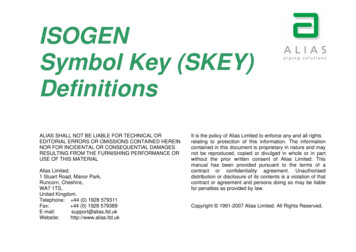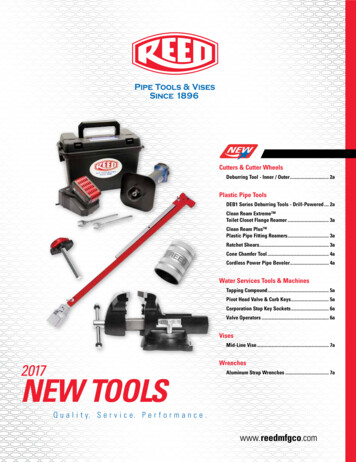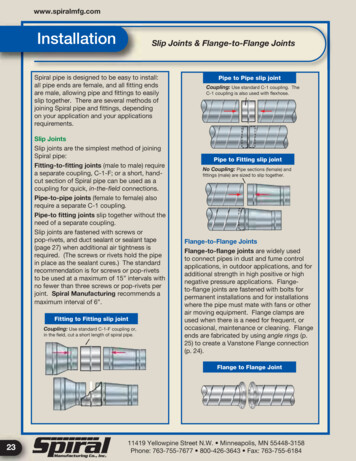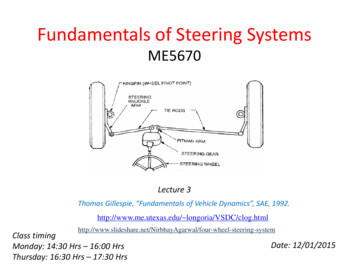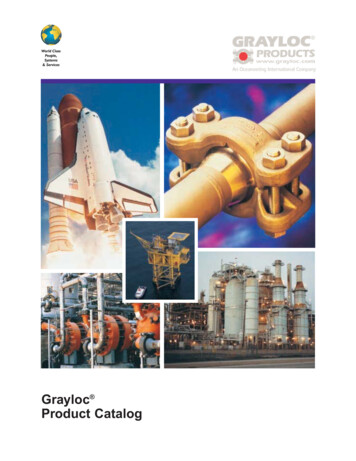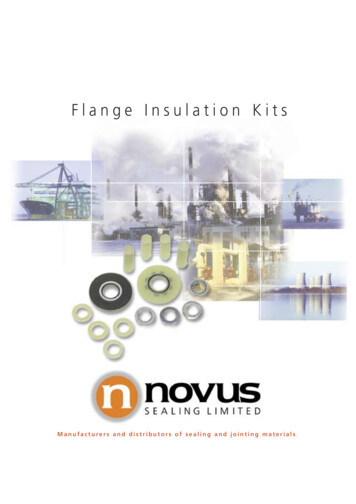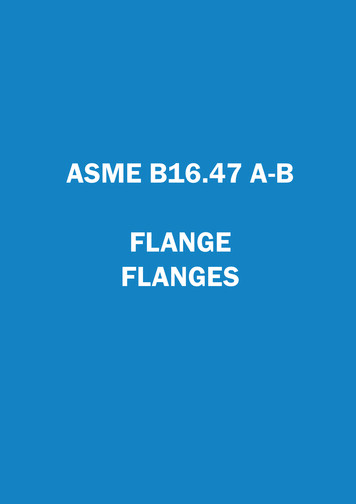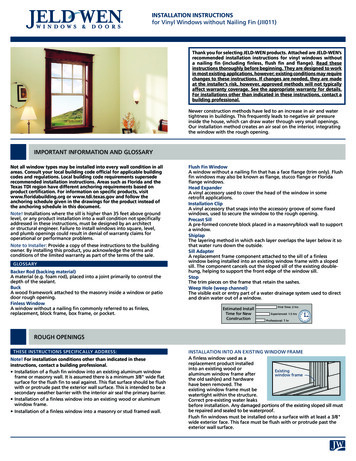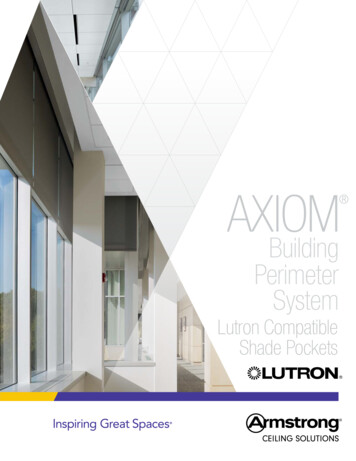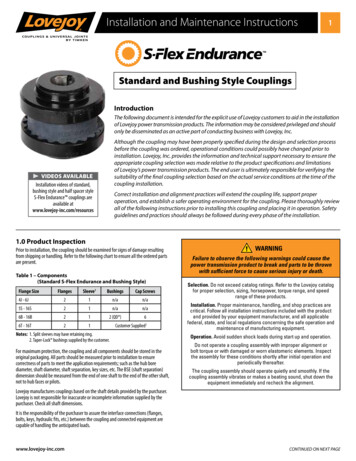
Transcription
Electric Duct HeaterSpecification and Installation InstructionsNomenclature:D FC I 0 0 HC: Open coil elementT: Tubular elementF: Finned tubular elementI: Slip in typeF: Flange type0: No screen left of the heater1: Screen left of the heater0: No screen right of the heater1: Screen right of the heaterH: Horizontal air flowV: Vertical air flowFeatures: Zero clearance construction Standard control panel door with removable hinges Horizontal or Vertical air flow Approved to CSA and UL standardsREAD AND SAVE THESE INSTALLATION INSTRUCTIONSTechnical dataMaximum inlet air temperatureMaximum outlet air temperatureMinimum distance from obstacle orobstruction in ductInlet bushingControl signalAir flow directionContact delay (ON/OFF stage(s))Model COpen Coil ElementsModels T or FTubular Elements95 F (35 C)81 F (27 C)200 F (93 C)3x duct diameter upstream and downstream of electric heater2 knock out 7/8’’ (22.2mm) or 1 ⅜’’ (34.9mm)Signal pneumatic or electric - On/Off or modulatingSee Electric diagramHorizontal or Vertical (refer to name plate)ON: 1 minute; OFF: 30 secondsVoltageCurrentPowerSee the name plateControl voltageMinimum air velocityEnsure minimum air flow – as marked on name plate.Caution, Risk of malfunction, In case of alteration (drilling holes or other) to the electrical compartment, ensure properprotection of all electrical components installed. Chips may cause short circuit or affect operation of electrical components.Caution, Risk of damage and malfunction, Ensure minimum air flow, insufficient airflow will lead to opening of mechanical airflow switch (PDN or PDA) or electronic air flow switch sensors (EAS) and automatic thermal cut-out. This may damage heatingelements and controls.!Important, direction of installation (refer to arrow on name plate) must be respected. Failure to do so will impair proper operationof thermal cut-out and/or cause overheating of solid state relay(s).Caution, Risk of malfunction, Do not proceed with modification or alteration to internal electric connection or component of theelectric heater. Any non-authorized modification will void the warranty.Heater-manual-1704271
Electric Duct HeaterSpecification and Installation Instructions1 DimensionsSlip in type -IStandardHeat sink only onmodulating electric heaterHeat sink only onmodulating electric heaterHeat sink only on modulating electric heaterH - (25.4mm)HA1'’ (25.4mm)1'’(25.4mm)CC2'’(51mm)CDD1 ½'’(38mm)Heat sink only onmodulating electric heaterHW1'’ (25.4mm)1'’ (25.4mm)1'’(25.4mm)1'’(25.4mm)1 ½'’(38mm)1'’(25.4mm)BW - 0.25'(6.4mm)AFlange type - FWith round adapterDHeat sink only on modulating electric heater2'’(51mm)1 ½'’(38mm)Heat sink only onmodulating electric heater2 Installation Tips2.1Air flow condition to avoid:Minimum distance for the conditions below is 3 times the duct diameter.Electric heater too close to Fan.Electric heater too close to filter.Avoid any abrupt transition after a fan.3x ductdiameterFilter3x ductdiameterFandOverheatOverheatElectric heater too close to transition.3x ductdiameterElectric heater too close to elbow.90 elbowOverheat3x ductdiameterdOverheatwww.neptronic.com2
Electric Duct HeaterSpecification and Installation Instructions2.2Minimum clearance to access control panel!Caution, for safety reasons, minimum clearance to access control panel must respect local electric code.Slip-in type electric heater - TypeW39" (1 m)IFlange type electric heater - Type(with or without round adapter)39" (1 m)No access doorin this areaMinimum clearance Duct Width (W) Cont. Panel Width (C) 3'’ (76mm)39" (1 m)C39" (1 m)No access doorin this areaNo access doorin this areaMinimumclearance Cont. Panel Width (C) 3'’ (76mm)No obstructionin this areaProvide a minimum clearance equal to W C 3’’ (76mm).!FCNo access doorin this areaNo obstructionin this areaProvide a minimum clearance equal to C 3’’ (76mm).Caution, Risk of electric shock and burns. A minimum distance of 39’’ (1m) must be maintained between heating sectionand any opening or access door in the duct. This applies to all types of heaters. If such distance cannot be maintained, aprotective guard (C22.2 No.155 section 4.1.8) must be installed to protect personnel from contact to heating elements andbare live parts.3 Handling! Warning, Risk of failure or malfunction. Do not operate electric heater if heating elements have been damaged duringtransport or handling.Protective packaging must be kept until installation.Electric heater must be handled with care, particularly for the Open Coil electric heater.4 Mechanical installation!Caution, Risk of damage and malfunction, Do not block air flow to heating elements, insufficient airflow may damageheating elements and controls.Important, direction of installation (refer to arrow on name plate) must be respected. Failure to do so will impair properoperation of thermal cut-out and/or cause overheating of solid state relay(s),Flange type electric heater - Type1)2)3)FPosition electric heater in front of the duct flange.Secure electric heater to the duct by using metal screws orbolts through the duct flanges.If necessary, install supports to maintain the electric heater.With round adapter option1)2)3)Insert electric heater between the two sections of the roundduct.Secure electric heater by using metal screws through roundflanges.If necessary, install supports to maintain the electric heater.Slip-in type electric heater - TypeI1) Cut an opening in the duct.Allow ¼’’ (6.3mm) more than the frame width ‘’D’’.2) Insert electric heater through the opening.3) Secure electric heater onto the duct using metal screws.2 flanges of 1’’ (25.4mm) are provided on each side of controlpanel.4) If necessary, re-enforce the duct rigidity by installingappropriate support(s).www.neptronic.com3
Electric Duct HeaterSpecification and Installation Instructions5 Electrical Installation 5.1DANGER: Risk of electric shock. Disconnect all supplies before working on any circuit.CAUTION: Risk of malfunction. Use only copper wires suitable for 221 F (105 C).CAUTION: Electric installation must be done by a qualified electrician and must conform to local electrical codes.CAUTION: If a disconnect switch and/or fuses have not been supplied on the control panel of the electric heater,disconnect switch and/or fuses must be installed on supply.CAUTION: Gauge of electric supply wires must be of appropriate section, function of line current, as per localelectrical codes.Power supply wiringSee the name plate for information on voltage and current. Connect all wires to appropriate terminals as per the electrical diagram affixed inside the control panel door. Correct connection tightening must be verified before start up, and after a short period of operation (typically after 2 weeks).5.2Typical electric diagram & legendSEPMICThermal cut-outautomatic resetLNESorAir flow switchor EAS**EPMICNESingle phase power supplyterminalsorThermal cut-outManual resetDisconnect switch3 phases power supplyterminalsNormally opencontactFuseGround terminalNormally closedcontactHeating elementContactor coilTransformerControl circuit supplyBack-up safetycontactor coilPneumatic electricswitch (ON/OFF)CommonPilot lightPneumatic electriccontroller(modulating)IInterlockSolid State Relay inputterminalSolid State Relay outputterminal**Note: Electronic air flow sensor (EAS) is available/installed for heaters less than 50A and dimensions less than 48”x40”. Somerestriction may apply.www.neptronic.com4
Electric Duct HeaterSpecification and Installation Instructions5.3Control signal selection and connection5.3.1Electric ON/OFF signalConnect the contact demand wires to terminals com & 1, 2, 3, etc of the electric heater.Information about mechanical Air flow switch (PDN or PDA)Upon application of 0.05’’w.c. (12Pa) minimum pressure, mechanical airflow switch will activate internal normallyopen and normally closed contact.Install pitot tube into the air duct up flow of electric heater.Make sure that the arrow is in the direction of air flow.AIR FLOW5.3.2Pneumatic ON/OFF signalConnect a ؼ’’ (6mm) pneumatic signal tube onto pneumatic electric switch to activate each of the heating stages.Information about Pneumatic electric switch(PSO or PSC)Upon application of demand pressure, pneumatic switchwill activate internal normally open (PSO) or normallyclosed (PSC) contact.Set point is adjustable from 2 to 20PSI (14 to 138kPa)5.3.3Pneumatic signalinlet portElectrical modulating signal, 0-10 or 2-10Vdc or 4-20mAConnect the control signal demand wires to terminals&of the electric heater. Information about Neptronic electronic controller (HEC)Jumper on2-10 of J1 J1J1Jumper onVDC of J2J2A19AC INA18STS3A17 INPUTA16LOWNo Jumperon J4COMA19AC INA18STS3 -A17 INPUTA16HIGHLOWNo Jumperon MTRO5404J212 34 56 7 8 9J2A19AC INA18STS3A16HIGHJ4DIGITALINPUT -ExternalSensor(optional)Common (-)-COMHECINPUT0-10 Vdc ( ) 24 Vac ( )2A17LOWNo Jumperon J4COMELECTRICHEATERA16A17 INPUTwww.neptronic.comJ2Signal 0-10 Vdc by Neptronic thermostat TRO54040-102-10Jumper onVDC of J2J2 -Signal 0-10 VdcJumper on0-10 of J1 J1J1Jumper onMA of J2VDCMASTS30-102-10Jumper on2-10 of J1 J1J2TPMVDCMASTS3TPM0-102-10Neptronic electronic controller (HEC) is a universal controller accepting any input signal used in the HVAC industry andconverting it to a modulating and/or ON/OFF control signal to solid state relay(s) and contactor(s).If the electric heater is equipped with only one modulating stage, part number is HEC0000; and if the electric heater is equippedwith more than one stage, part number is HEC0002 or HEC0005.Signal 2-10 Vdc4-20mA Input5
Electric Duct HeaterSpecification and Installation Instructions5.3.4Electric digital signal, AC or DCConnect the control signal demand wires to terminals A16 & A19 for an AC signal or& for a DC signal.Information about Neptronic electronic controller (HEC)J1A19AC INA18STS3HOTJ1No Jumperon J2VDCMASTS30-102-10No Jumperon J1 J1J2No JumperJ1on J1No Jumper J2on J2TPMVDCMASTS3TPM0-102-10If the electric heater is equipped with only one modulating stage, part number is HEC0000; and if the electric heater is equippedwith more than one stage, part number is HEC0002 or HEC0005.AC Digital Input (Hot to 24 VAC)AC Digital Input (Ground)J2J2A19AC INA18STS3A17 INPUTA16Jumper onHIGH of J4A17 INPUTCOMLOWINPUTA16RETURNCOMRETURNHIGHLOWJumper onLOW of J4J4DIGITALINPUTHIGHJ4DIGITALINPUTThe position on J1 and J2 will not matter. The signal on A19 will be priority. The position on J1 and J2 will not matter. The signal on A19 will be priority.Jumper onTPM of J1 J1J1Jumper onVDC of J2TPMVDCMASTS3Signal pulse by Neptronic thermostat TRO54040-102-10DC Pulse InputTRO5404J2J2A19AC INA18STS3A165.3.5 -ExternalSensor(optional)-Common (-)COMHECINPUTHIGHDC pulse output ( ) 24 Vac ( )2A17LOWNo Jumperon J4COMA16A17 INPUTELECTRICHEATER12 34 56 7 8 9J4DIGITALINPUTElectric Neptronic signal, resistiveConnect the control signal demand wires to terminals A17 & A18 of the electric heater.Internal set point option:Note: Internal set point option is available with the followingVDCMASTS3TPMAdjustment of the internal set point:Adjust potentiometer INT SP at the desired temperature asmeasured in the duct (if you use a STC8-13) or in the room(if you use a STR1-13).0-102-10Temperature set point is adjustable directly on the electric heater, preventing over adjustment by user.Part number of the electronic controller is HEC000P.Internal set point & STC8-13 or STR1-13Internal Set Point(only on model HEC0000P)Control range: 61ºF to 100ºF [16ºC to 38ºC]J1J2P17264No JumperJ1on J1Jumperon STS3 J2of J2Jumper on J3INT of J3limitations:1. Model open coils only.2. 1 heating stage only of 10 kW maximum.3. Dimension of W 48’’ (1.2m) and H 40’’(1m) maximum.68788361 J3INT/EXT90A19 AC INA18A17 INPUTA16LOWNo Jumperon J4STC8-13STS3orCOMSTR1-13HIGHJ4DIGITALINPUTNo internal set pointJ1No JumperJ1on J1Jumperon STS3of J2A19J2A18No JumperJ1on J1Jumper onSTS3 of J2AC If the electric heater is equipped with only one modulating stage, part number of electronic controller is HEC0000; and if theelectric heater is equipped with more than one stage, part number is HEC0002 or HEC0005.STS3-13ITO3 & STC8-13 or STR1-13J2J2STS3-13A19AC INA18STS3A17 INPUTA17 INPUTA16A16No Jumperon GITALINPUTNo Jumperon J4HIGHorJ4DIGITALINPUTSTR1-136
Electric Duct HeaterSpecification and Installation Instructions5.3.6Pneumatic modulating signal, 0-15 PSIConnect the tube of the pneumatic signal to the port high pressure and leave the other port free.Information about pneumatic electric controller (PCD or PCR)Upon a pneumatic signal from 0-15 PSI (0 to 103kPa); and a minimum differential of 4 PSI (27kPa), pneumatic electric controllerwill send a 0 to 10Vdc electric signal to HEC. Direct (PCD) or reverse (PCR) acting preset at factory.Part number of the Neptronic electronic controller when used with pneumatic electric controller is HEC1000.Operation:Jumper on0-10 of J1 J1Jumper onVDC of J2J1VDCMASTS3TPM0-102-1024VacJ2J2A19AC INA18STS3Pressure input ( )A17 INPUTA16LOWNo Jumperon J4COMHIGHJ4DIGITALINPUT6 Operation conditionAir Flow : Air flow must not be lower than the minimum air flow indicated on name plate. Air flow going through the electric heater must be free of combustible particle, flammable vapour or gas. Open Coil: Air flow going through the electric heater must be free of dust.Zero clearance construction: Neptronic electric heaters are designed and approved for zero clearance to combustible material. Insulation material may beinstalled directly onto electric heater surfaces or onto air duct. However control panel must be accessible for maintenance.Warning, Risk of fire and/or malfunction, Do not install insulation directly on heating elements.7 Maintenance Neptronic electric heater does not require specific maintenance; however, we recommend a yearly inspection, typically before winterseason or after a long term shut down.1) Visual inspectionRisk of electric shock. Disconnect all supplies before any visual inspection. Verify good condition of heating element.Heating element must be clean, free of dust or lint. Open Coil: Verify carefully that there is no dust accumulation. Any dust of lint accumulation can lead to fire hazard. Verify any indication of overheating condition (discoloration) as well as any trace of oxidation (rust).2) Electrical inspectionRisk of electric shock. Disconnect all supplies before any electrical inspection. Verify correct electrical connection tightening.Verify the good condition of fuses (if any).Verify resistance of each circuit against ground.Verify correct operation of contactor(s).If necessary, electrical component must be replaced only with identical original component.www.neptronic.com7
Electric Duct HeaterSpecification and Installation Instructions8 Quick Troubleshooting GuideRisk of electric shock. Disconnect all supplies before any electrical inspection and troubleshooting.Any service and troubleshooting must be done by a qualified electrician.Symptom: Electric heater does not react to heating demand.Troubleshooting stepsNote: these steps must be followed as presented, failure to do so will lead to improper and incorrect diagnostic.1. Check that automatic and manual reset thermal cut-out is in closedposition.2. Check for 24Vac (control voltage) at the secondary fuse.Check for 24Vacat control fuseIf Electric ON/OFF signal3. Check for air flow in air duct and for proper action of air flow switch (refer to section 5.3.1 of this manual). If the air flowswitch does not react (closing the normally open contact) to air flow, verify the air flow switch and pitot tube installation. Ifthe air flow switch still does not react to air flow after being verified, it indicates that it is defective and must be replaced.If Electric modulating signal3. Depending on the control signal (refer to the appropriatesection from 5.3.3 to 5.3.6 of the manual) verify that controlsignal jumper(s) setting and connections are correct.4. Check for control signal to the appropriate control signalinput terminal on the HEC Pcb. If control signal is notpresent, check for control wirings between thermostat andelectric heater.5. If the electric heater is equipped with the electronic air flowsensor, disconnect the sensor Ts1 and Ts2 one at a timeand then both simultaneously. If the heater starts tooperate, search for a short in wiring or in the sensorsthemselves. The sensors may have to be replaced.6. Verify proper operation of HEC Pcb. When control demandis at 50%, the TPM green LED (LD5) must blinkaccordingly. If LED is not blinking, HEC Pcb is defectiveand must be replaced.7. Verify proper action of Solid state relay(s) (SSR). Whendemand is at 0%, output voltage to SSR at the outputterminals on HEC Pcb must be between 0 to 0.2Vdc. Whendemand is 100%, output voltage must be 25Vdc. If outputvoltage to SSR does not correspond to these values, HECPcb is defective and must be replaced.8. If the electric heater is equipped with more than onemodulating heating stage (typically first stage is modulatingand supplemental stages are on/off), verify operation ofon/off relay(s). When heating demand is at 100%, 24Vacmust be present to corresponding contactor coil and thecontactor contact must close.If control voltage (24Vac) is not present or contactor contactis not closing, the HEC Pcb or wiring is defective.Step 3Control signal selection jumpersStep 6TPM GreenLEDOutput terminals to heatingstages contactorsStep 7Output terminals to SSR(s)Step 5Input terminals from electronic airflowsensors9 Technical SupportFor any questions or specific requests, please consult our website: www.neptronic.comOr call: 1 800 361-2308, and ask for the Electric Heater Department.or (514) 333-1433Fax : (514) 333-3163www.neptronic.com8
1) Cut an opening in the duct. Allow ¼'' (6.3mm) more than the frame width ''D''. 2) Insert electric heater through the opening. 3) Secure electric heater onto the duct using metal screws. 2 flanges of 1'' (25.4mm) are provided on each side of control panel. 4) If necessary, re-enforce the duct rigidity by installing
